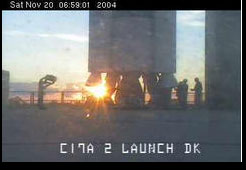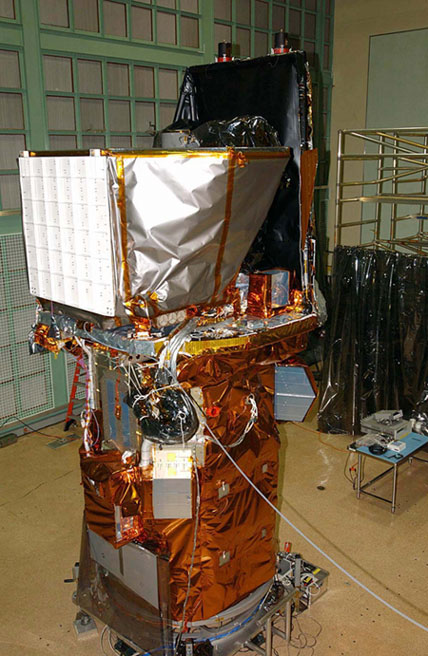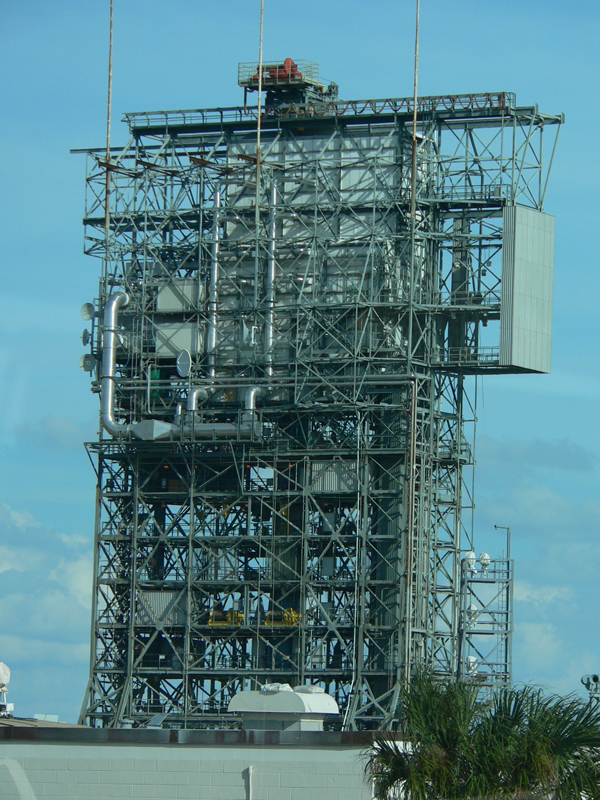ISAS/JAXA International Collaboration
Swift Mission
Swift has been developed as part of an international mission to study the mystery of, so called, the Gamma-ray bursts, the most powerful explosions that the Universe has seen. Takahashi Group of Institute of Space and Astronautical Science, JAXA and Tashiro Group of Saitama University, together with Makishima Group of Tokyo University, have been participating with the Swift project since 2000. Our efforts have been particularly focused on the development of the Burst Alert Telescope (BAT). BAT has a large view area and is designed to automatically identify a Gamma-ray burst's location, to provide the satellite a trigger to instantly adjust its entire attitude towards the burst's direction.
Institute of Space and Astronautical Science, JAXA is assigned as one of Key Associate Institutions to lead the efforts and developments made by Japanese researchers.
@After the launch, and its normal movement is once confirmed, Swift is to be operated to detect Gamma-ray bursts, which are expected to take place approximately once every three days. Information including a burstfs location and brightness will be sent to the ground stations within seconds, once they are identified, and be relayed to astronomical observatories around the globe. Swift data will be made public for researchers throughout the world. It is hoped that the study of gthe Gamma-ray bursts,h one of the biggest mysteries in the field of astronomy, will be advanced by unanimous efforts.
Swift will be launched by Delta II rocket from Kennedy Space Center on November 18, 2004.
- For the local information of the launch: (video recordings etc.)
- Swift Home Page (NASA/GSFC)
- Swift participating institutions
- Swift member list
- BAT

On the 20th of Nov, 2004
NASA Cape Canaveral Air Force Station
About Gamma-ray Bursts
Gamma Ray Bursts(GRBs) are the phenomena that release an enormous amount of energy in a form of electromagnetic waves mainly from the gamma ray region within a time range between several seconds to several tens of seconds. The region is between 50 and 300 keV where the most brightly shining cosmic fluxes are recorded more than 100 counts every second per one square centimeter of the detector. Instantaneously, the level of counts can greatly exceed that for the Crab nebula, which is known as the bright gamma-ray source. These phenomena were discovered in 1968 by VELA satellite that had been launched to look out for any nuclear testing on the ground. Since then, they were the mystery. BATSE detector of the Compton satellite has recorded over 2,000 GRBs since its launch, and has revealed that GRBs are located similarly throughout the space.
In 1997, we saw a dramatic development in the study of GRBs. An Italian X-ray satellite, BeppoSAX has managed to determine an exact location of a burst source for the first time, using its own GRB monitor equipment and a wide-field-view X-ray camera. Once a burst location is determined, visible light and infrared rays telescopes on the ground, for example KECK and Hubble Space Telescopes, could perform further detail observations. As a result, we have learned that origins of such GRBs are located far beyond our Galaxy, supposedly from 7 to 11 billion light-years far in terms of the distance. Despite the fact that the phenomena are happening so far away, we observe extremely high-level fluxes. This means that the energy released is exceedingly enormous. Though some scientists believe that GRBs are the moment from which we can observe births of huge black halls at early eras of the Universe, the complete picture of GRBs is still covered with mysteries. And studies in this field will continue to progress day by day.
Swift is carrying wide-FOV Gamma-ray imager named BAT (Burst Alert Telescope), which is capable of covering one sixth of the space. Its sensitivity is approximately between 10 keV and 150 keV. BAT constantly monitors any occurrence of GRBs within its view. When it identifies a burst, it derives the burstfs location, by operating the computer installed with the satellite. The angular range of the angular resolution that the computer achieves is within a range of some minutes. Based on such location information, we adjust the entire satellite position toward the origin of the burst within a time range from 20 to 70 seconds. Applying telescopes to observe ultraviolet and X-rays that are also equipped with the satellite, we further observe the burst to finally determine its location more precisely within an angular range between 0.3 and 2.5 arc seconds, thanks to the extremely high-resolution capability of the telescopes. Swift is to determine and release the exact location information of a GRB, as well as to study changes in multi-frequency spectra including ultraviolet, X-, and Gamma- rays to explore the truths of GRBs and their surrounding environment.
Papers, Conferences
- The Swift Gamma-Ray Burst Mission
- (N. Gehrels et al., ApJ, ,611, pp. 1005-1020,2004)
- Development of a Spectral Model Based on Charge Transport for the Swift/BAT 32K CdZnTe Detector Array
- ( Goro Sato, Ann Parsons, Derek Hullinger, Masaya Suzuki, Tadayuki Takahashi, Makoto Tashiro, Kazuhiro Nakazawa, Yuu Okada, Hiromitsu Takahashi, Shin Watanabe, Scott Barthelmy, Jay Cummings, Neil Gehrels, Hans Krimm, Craig Markwardt, Jack Tueller, Ed Fenimore, David Palmer, Nucl. Instr. Meth. A, in press, 2004 [PDF 3.9 MB] )
- Data Processing of Burst Alert Telescope onboard the Swift satellite
- ( H. Takahashi,Y. Okada, G. Sato, K. Nakazawa, T. Takahashi, S. Watanabe, M. Suzuki, M. Tashiro, S. Barthelmy, J. Cummings, N. Gehrels, D. Hullinger, H. Krimm, C. Markwardt, A. Parsons, J. Tueller, E. Fenimore, D. Palmer, in New Horizon of the Gamma-Ray Burst Astronomy, Wako, Japan, 2004 [PDF 0.16 MB] )
- Ground calibration of Burst Alert Telescope aboard Swift
- (Y. Okada, H. Takahashi, M. Suzuki, G. Sato, M. Tashiro, K. Nakazawa, T. Takahashi, S. Watanabe, S. Barthelmy, J. Cummings, N. Gehrels, D. Hullinger, H. Krimm, C. Markwardt, A. Parsons, J. Tueller, E. Fenimore, D. Palmer, in New Horizon of the Gamma-Ray Burst Astronomy, Wako, Japan, 2004 [PDF 0.75 MB] )
- Energy response of CdZnTe detectors in the BAT onboard Swift satelite
- (M. Suzuki, Y. Okada, G. Sato, H. Takahashi, M. Tashiro, K. Nakazawa, T. Takahashi, S. Watanabe, S. Barthelmy, J. Cummings, N. Gehrels, D. Hullinger, H. Krimm, C. Markwardt, A. Parsons, J. Tueller, E. Fenimore, D. Palmer, in New Horizon of the Gamma-Ray Burst Astronomy, Wako, Japan, 2004 [PDF 0.73 MB] )
- GRB observations with Astro-E2 in the Swift Era
- ( Makoto Tashiro, in New Horizon of the Gamma-Ray Burst Astronomy, Wako, Japan, 2004 [PDF 0.54 MB] )
- Swift/BAT calibration and the estimated BAT hard x-ray survey sensitivity
- ( Ann Parsons, Jack Tueller, Hans Krimm, Scott D. Barthelmy, James Cummings, Craig Markwardt, Derek Hullinger, Neil Gehrels, Ed Fenimore, David Palmer, Goro Sato, Kazuhiro Nakazawa, Tadayuki Takahashi, Shin Watanabe, Yuu Okada, Hiromitsu Takahashi, Masaya Suzuki, Masaya, Makoto Tashiro, Hard X-Ray and Gamma-Ray Detector Physics V , SPIE, 5165, pp. 190-200, 2003 )
- Properties of CdZnTe detectors in the burst alert telescope (BAT) array
- ( Goro Sato, Tadayuki Takahashi, Kazuhiro Nakazawa, Shin Watanabe, Makoto Tashiro, Masaya Suzuki, Yuu Okada, Hiromitsu Takahashi, Ann Parsons, Jack Tueller, Hans Krimm e, Scott Barthelmy, Jay Cummings, Craig Markwardt, Derek Hullinger, Neil Gehrels, Ed Fenimore, David Palmer, Tony Dean, and Dave Willis, Hard X-Ray and Gamma-Ray Detector Physics V , SPIE, 2003, in press [PDF 0.95 MB] )

